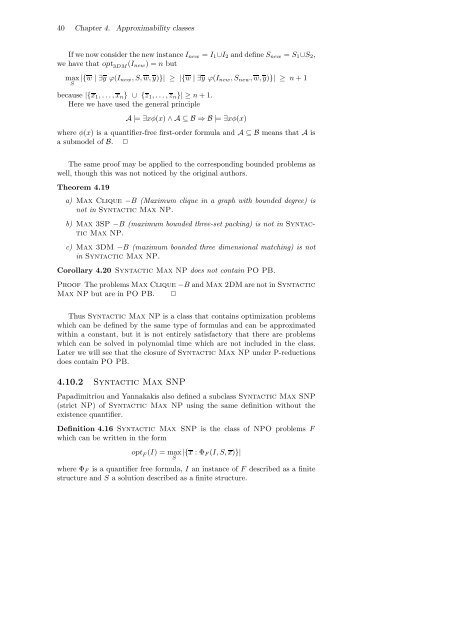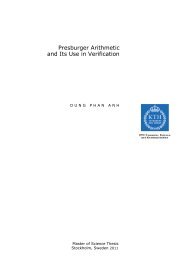On the Approximability of NP-complete Optimization Problems
On the Approximability of NP-complete Optimization Problems
On the Approximability of NP-complete Optimization Problems
Create successful ePaper yourself
Turn your PDF publications into a flip-book with our unique Google optimized e-Paper software.
40 Chapter 4. <strong>Approximability</strong> classes<br />
If we now consider <strong>the</strong> new instance Inew = I1∪I2 and define Snew = S1∪S2,<br />
we have that opt 3DM (Inew) =n but<br />
max<br />
S |{w |∃yϕ(Inew,S,w, y)}| ≥ |{w |∃yϕ(Inew,Snew, w, y)}| ≥ n +1<br />
because |{x1,...,xn} ∪ {z1,...,zn}| ≥ n +1.<br />
Here we have used <strong>the</strong> general principle<br />
A|= ∃xφ(x) ∧A⊆B⇒B|= ∃xφ(x)<br />
where φ(x) is a quantifier-free first-order formula and A⊆Bmeans that A is<br />
a submodel <strong>of</strong> B. ✷<br />
The same pro<strong>of</strong> may be applied to <strong>the</strong> corresponding bounded problems as<br />
well, though this was not noticed by <strong>the</strong> original authors.<br />
Theorem 4.19<br />
a) Max Clique −B (Maximum clique in a graph with bounded degree) is<br />
not in Syntactic Max <strong>NP</strong>.<br />
b) Max 3SP −B (maximum bounded three-set packing) is not in Syntactic<br />
Max <strong>NP</strong>.<br />
c) Max 3DM −B (maximum bounded three dimensional matching) is not<br />
in Syntactic Max <strong>NP</strong>.<br />
Corollary 4.20 Syntactic Max <strong>NP</strong> does not contain PO PB.<br />
Pro<strong>of</strong> The problems Max Clique −B and Max 2DM are not in Syntactic<br />
Max <strong>NP</strong> but are in PO PB. ✷<br />
Thus Syntactic Max <strong>NP</strong> is a class that contains optimization problems<br />
which can be defined by <strong>the</strong> same type <strong>of</strong> formulas and can be approximated<br />
within a constant, but it is not entirely satisfactory that <strong>the</strong>re are problems<br />
which can be solved in polynomial time which are not included in <strong>the</strong> class.<br />
Later we will see that <strong>the</strong> closure <strong>of</strong> Syntactic Max <strong>NP</strong> under P-reductions<br />
does contain PO PB.<br />
4.10.2 Syntactic Max S<strong>NP</strong><br />
Papadimitriou and Yannakakis also defined a subclass Syntactic Max S<strong>NP</strong><br />
(strict <strong>NP</strong>) <strong>of</strong>Syntactic Max <strong>NP</strong> using <strong>the</strong> same definition without <strong>the</strong><br />
existence quantifier.<br />
Definition 4.16 Syntactic Max S<strong>NP</strong> is <strong>the</strong> class <strong>of</strong> <strong>NP</strong>O problems F<br />
which can be written in <strong>the</strong> form<br />
optF (I) =max<br />
S |{x :ΦF (I,S,x)}|<br />
where ΦF is a quantifier free formula, I an instance <strong>of</strong> F described as a finite<br />
structure and S a solution described as a finite structure.

















